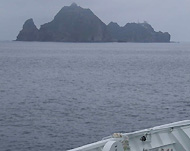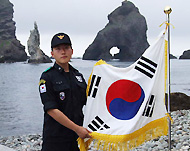Islands of discontent
The islands, lonely and uninviting at the best of times, rise almost sheer out of the sea between South Korea and Japan.

They are topped by a helicopter pad, communications towers and accomodation units for South Korean policemen.
But, despite appearances, these barren rocks – known as Dokdo in Korea and Takeshima to the Japanese – are deeply symbolic to both sides.
Many see the dispute over the ownership of the islands – 217km from Korea and 250km off mainland Japan – as a modern continuation of the ancient rivalry between these east Asian countries.
Captain Kang Lee-Hwang, the head of the South Korean Police unit guarding Seoul’s most easterly outpost, told Aljazeera.net: “I feel a strong sense of responsibility and that we are underlining the message that Dokdo is our land and that we will protect the residents and our territory.
“Japan’s claim to these islands is completely out of the question.”
‘Pride’
Captain Kang, 23, and the 30 men under his command wear black uniforms, combat boots and baseball caps, with a badge depicting the outline of the islands on their breast pockets. The captain says he is ready to put his life on the line to protect South Korean territory.
|
“Japan’s claim to these islands is completely out of the question” Captain Kang Lee-Hwang, |
“This is a very important area,” he says. “I am doing my duty by working for my country and that gives me a real sense of pride.”
Since the island was opened to day-trippers in 2005 there have been some Japanese who have made the journey, the captain says, adding that he is “confused and upset” at Tokyo’s claims to the island but hopes that the two nations can get along in the future.
Steep steps lead to the top of the 99-metre peak of Dongdo, the most easterly of the two main isles, passing a series of grave markers of Koreans who have died in accidents in the 54 years since Seoul began stationing guards there.
Hardship posting
Physically Dokdo is a hardship posting, with the police rotating off the island every three months, but for two people, the 187,450 sq metre islands are home.
 |
|
Koreans are not willing to give |
At the base of steep cliffs on Seodo, across the channel from the pier where the tourists arrive, is the home of fisherman Kim Seong-do, 66, and his 68-year-old wife, Si-yul.
“We have lived here for 40 years now and we make a living from the sea, selling the fish and shellfish to the island of Ulleungdo,” says Kim. “When we first arrived there were about 15 people, but we’re the only ones left now. We sent our three children to the mainland for their schooling and they have stayed there, but I can’t say that we get lonely, not after all these years.
“We have a television and a regular phone line was installed a couple of months ago, so we can speak to the children and the grandchildren,” he says. “I guess I get off the island a couple of times each year, if I have to see the doctor on Ulleungdo.”
The Kims prefer not to dwell on the territorial dispute that rages between the two governments on either side of them; earning a living among the 33 rocks and reefs that make up their home is a sufficient task.
Takeshima Day
“This topic has been here for many years, but it only became amplified when the government of Japan’s Shimane prefecture last year declared February 22 as Takeshima Day and the South Korean side reacted quite astonishingly,” said Akira Chiba, a spokesman for the ministry of foreign affairs in Tokyo. “Their response is the origin of the most recent problems between the two governments.”
 |
|
The Kims are the only permanent |
Although Shimane’s move did not have the backing of the national government, local officials passed the proposal saying that it would promote new interest in reasserting Japan’s claims to the island.
The immediate reaction was the cancellation of a series of exchange programmes and the postponement of a trip to Japan by Ban Ki Mun, the South Korean minister of foreign affairs and trade.
To support their respective claims both sides have produced reams of historical documents and maps dating back hundreds of years.
Further complicating the issue is the fact that the isles have been known by various names through the centuries. Usando, Sambongdo, Gajido and Seokdo to Koreans translates to Matsushima and Riyangkoto in Japanese.
Then there is Liancourt Rocks, so named after the French whaling ship which became the first Western vessel to chart their position in 1849.
Key claims
Whatever the name of the islands, Japan dismisses the dispute over the oldest name as “not very constructive,” according to Mr Chiba.
Instead, Tokyo bases its claim on two key pillars. Firstly, Japan’s proclamation in 1905 that the islands were Japanese territory was not met with a rebuttal from Korea.
Secondly, Tokyo points out, after Japan’s defeat in the second world war in 1945, Korea asked the US occupation authorities in Japan to declare Dokdo to be Korean territory; that attempt was rebuffed on the grounds that there was no evidence to support the claim.
Not surprisingly, the government and people of South Korea strongly disagree with Japanese assertions and display a degree of national pride at getting one over on a long-term rival and former colonial master.
Bumper stickers in east-coast towns proclaim Dokdo as an integral part of the homeland and telephone cards bear the islands’ profile, along with suitably nationalistic slogans.
Agree to disagree
Perhaps the only area that the two sides agree upon is that the issue of different names is causing problems.
 |
|
The pride of two nations are at |
But according to Lee Seokwoo, a professor at Incheon’s Inha University in South Korea and an authority on territorial disputes, that does not change the fact that Korea has exercised sovereignty over Dokdo since 512 BCE – interrupted only by the 1910-1945 period of Japan’s colonial occupation.
Japan’s arrival on the islands in 1904 was the harbinger of what was to come for East Asia, he believes.
“Many Koreans are of the opinion that Dokdo was the very first victim of Japanese imperialism because it was used as the initial stepping stone in the imperialist approach to Korea and beyond,” he says.
Seokwoo provides an extensive collection of maps to support Seoul’s claims to the islands, including a 1785 sketch by a Japanese cartographer named Shihei Hayashi on which the islands are marked as “belonging to Korea”.
Similarly, he cites the hand-written note dating from March 20, 1877, and bearing the prime minister’s seal confirming that Dokdo belonged to Korea on the grounds that the islands “are irrelevant to Japan”.
International arbitration
South Korea’s position on the islands is weakened, however, by its refusal to agree to a Japanese proposal to take the dispute to the International Court of Justice in The Hague.
“In all the outstanding territorial disagreements around the world, this one is historically unique because it involves the former colonising power and the colonised country,” says Professor Lee.
“The government does not think that the court could take the historical relationship seriously and it does not know whether the evidence that would be presented to the court would be effective.
“Korea is concerned about an unpredictable outcome and that we could lose this case,” he admits. “If Seoul agreed to go to an international court, it would lose the advantage that it enjoys at the moment by being in control of the islands.”
And if the ruling was not in favour of Korea, no [sitting] government that had agreed to go through mediation would be able to survive,” he says.